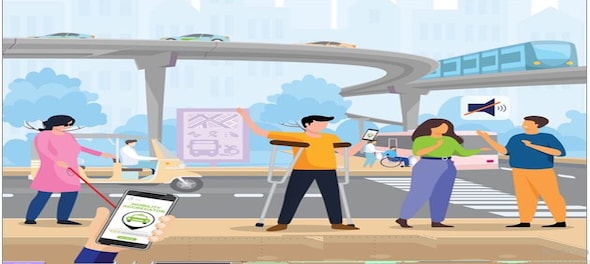
The pragmatic yet ambitious Budget 2022-23 lays a blueprint for the day after tomorrow, for India at 2047. The focus areas of the budget - multimodal connectivity, inclusive development, energy transition, and climate action, among others - are pivotal for the Amrit Kaal of the next 25 years.
Integral to India’s journey of becoming a global economic powerhouse is the transformation of cities to hubs of sustainable living with opportunities for all including women and the youth. To this end, announcements on transit-oriented development, modernization of building bye-laws, town planning schemes, and augmenting urban rejuvenation mission (AMRUT and smart cities) with an outlay of Rs 14,100 crores form a step in the right direction. Recognizing that over 50 percent of the population would be urban in 25 years, the budget proposes the creation of a high-level committee and setting up of 5 centers of urban planning excellence with an endowment of Rs 250 crores each. These measures can steer a paradigm shift, nurturing megacities and hinterlands as economic powerhouses, while empowering tier-2 and 3 cities to take on the mantle in the future.
This metamorphosis of urban India can only be sustained by enabling convenient, affordable, and safe access to economic opportunities for all. Thus, the budget’s thrust on promoting public transportation is a progressive move. As next steps, the government should announce a comprehensive public transport transformation plan to achieve improved service levels and operational efficiency through digitalization, and consequent financial viability. Modernizing bus systems through real-time tracking and demand-supply matching, digital ticketing, and payments, can attract and retain commuters of all ages and genders. This needs to be supplemented by an immediate substantial increase in the number of buses per 1000 population, and the promotion of new-age shared mobility such as digitalized auto-rickshaws, taxi-cabs, bike taxis. Thus, the first 100 days of the budget rollout is critical for India to lay the right foundation for catapulting the public transport system to the 21st century, and catering to the needs and aspirations of a burgeoning urban population.
To strengthen public transport further, multimodal connectivity is essential. The government recognizes the challenges posed by insufficient first- and last-mile connectivity and proposes the creation of an Open-source Mobility Stack for enabling multimodal and seamless passenger movement. This is complemented by the Unified Logistics Interface Platform facilitating the transport of goods across India. The budget emphasizes multimodal connectivity between mass urban transport and railway stations, in addition to reimagining metro systems for Indian needs and aspirations. Multimodal connectivity - across roads, railways, airports, ports, mass transport, waterways, and logistics infrastructure, as envisaged under PM GatiShakti - forms the fulcrum of India’s transformative approach for higher productivity, economic growth, and sustainable development.
Doubling down on India’s commitment to sustainability, this budget allocates Rs 2,908.28 crores for electric vehicle subsidies under the FAME scheme, a four-fold increase over last year. Along with the proposal to introduce interoperability standards and promote energy-as-a-service, the budget promises to catapult India to a global EV hub. As per the Vahan database, under 1,000 EVs are sold in India every day of which 95 percent are two- and three-wheelers. This figure is sure to grow exponentially in the coming year, with the combined effect of ease of charging and increased purchase incentives. The budget, further, provides for decarbonizing public transport, and the creation of special mobility zones with zero fossil fuel use. By focusing on cleantech, the budget succeeds at paving the way for a carbon-neutral economy.
One cannot sufficiently underscore how holistic Budget 2022-23 is when it comes to clean mobility and sustainable living. Recognizing the dangers of unsustainable consumption from a climate change perspective, the budget bats for mindful and deliberate utilization, as proposed by the Prime Minister at the COP26 summit. Thus, it emphasizes a sustainable economic transition complying with circular economy principles. Here, end-of-life management of vehicles and batteries, achieving cradle-to-cradle sustainability, gain significance. With India’s thrust on large-scale localized manufacturing and cleantech consumption in a hyperdrive, it will be imperative to leverage the budget to formally reuse, recycle, and extract raw materials from expired or unfit assets (urban-mine). Indeed, FY22-23 might be the year that India announces its global urban mining aspirations.
Sustainability, therefore, unlocks not just economic opportunities, but also the scope of creating millions of livelihoods. India needs to take the lead in the seven sunrise sectors recognized in this budget, to stay ahead of the curve. A start has been made in the space economy, green energy, and clean mobility systems, while artificial intelligence, geospatial systems, and drones are the new frontier. Together it holds the promise of effectively revolutionizing urban mobility and regional connectivity in India.
Overall, it is noteworthy that the budget prioritizes urbanization, connectivity, clean mobility, and sustainable development in line with past budgets, and further the efforts of the Indian government. In the challenging times marked by the COVID-19 pandemic, Budget 2022-23 signals consistency and policy stability engendering the trust of not only businesses and entrepreneurs but the citizenry as well.
-The author Aishwarya Raman is Director and Head of Research at the Ola Mobility Institute. The views expressed are personal.
For all the Budget 2022 related news, click here.
(Edited by : Pradeep Suresh V)
First Published: Feb 10, 2022 5:25 PM IST
Check out our in-depth Market Coverage, Business News & get real-time Stock Market Updates on CNBC-TV18. Also, Watch our channels CNBC-TV18, CNBC Awaaz and CNBC Bajar Live on-the-go!


Prajwal Revanna Sexual Assault Case: Activist raises concerns over political interference, delayed investigation in the matter
Apr 30, 2024 10:17 PM
Lok Sabha Election 2024: Baramati election outcome will decide the future of Pawar dynasty, says expert
Apr 30, 2024 10:08 PM
Lok Sabha elections 2024: Baramati to Mainpuri, key battles in phase 3
Apr 30, 2024 7:01 PM

